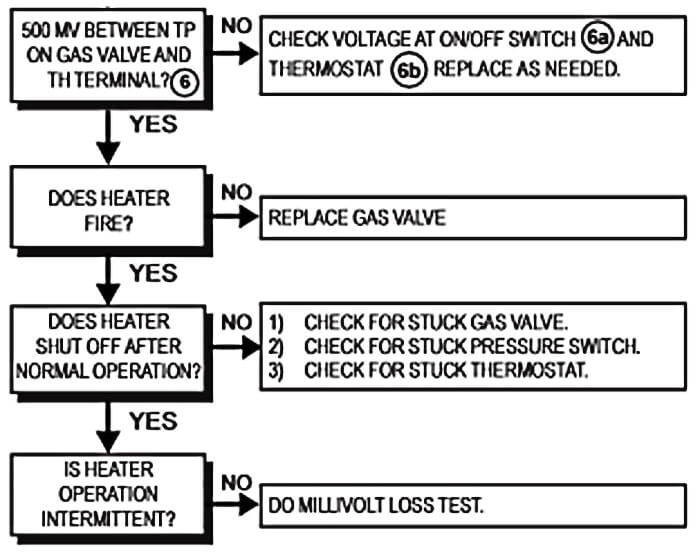Having trouble with your Hayward Millivolt pool heater? You’re not alone.
Many pool owners face issues with this popular heating system. A reliable pool heater is essential for a comfortable swim, regardless of the season. When your Hayward Millivolt pool heater malfunctions, it can disrupt your pool enjoyment. Common problems include ignition failure, pilot light issues, and inconsistent heating.
Understanding these problems can save you time and money. In this guide, we’ll explore practical troubleshooting steps. With a few simple checks, you can often identify and fix the problem yourself. This can help you avoid costly repairs and keep your pool warm and inviting. Let’s dive into the world of Hayward Millivolt pool heater troubleshooting.
Common Issues
Even the best pool heaters can have problems. The Hayward Millivolt pool heater is no exception. Knowing the common issues helps in troubleshooting effectively. This section covers frequent problems you might face with your Hayward Millivolt pool heater.
Heater Not Igniting
A common problem is the heater not igniting. This could be due to a variety of reasons:
- Pilot Light: Check if the pilot light is out. If it is, relight it.
- Gas Supply: Ensure there is gas supply to the heater.
- Thermopile: A faulty thermopile can prevent ignition. Test it with a multimeter.
- Wiring Issues: Inspect the wires for any damage or disconnections.
If the heater still does not ignite, it might be due to a more complex issue. Consulting a professional might be necessary.
Heater Not Reaching Desired Temperature
Sometimes, the heater ignites but does not reach the desired temperature. Here are possible reasons:
- Thermostat: Ensure the thermostat is set correctly. It should match your desired temperature.
- Water Flow: Low water flow can prevent the heater from working efficiently. Check for any blockages.
- Heat Exchanger: A dirty or damaged heat exchanger can reduce heating efficiency. Clean or replace it as needed.
- Gas Pressure: Low gas pressure can affect the heater’s performance. Verify the gas pressure is adequate.
Checking these aspects can help you identify why the heater is not reaching the desired temperature. Regular maintenance can prevent many of these issues.

Credit: www.amazon.com
Tools Needed
To troubleshoot your Hayward Millivolt Pool Heater, having the right tools is crucial. Using the correct tools helps ensure accurate diagnostics and effective repairs. Below, we discuss the basic tools and specialized equipment you’ll need for this task.
Basic Tools
Basic tools are essential for most troubleshooting tasks. They help you perform common checks and fixes. Here is a list of basic tools:
- Screwdrivers: Both flathead and Phillips screwdrivers are needed to remove and tighten screws.
- Wrenches: Various sizes of adjustable wrenches help loosen and tighten nuts and bolts.
- Pliers: Needle-nose and standard pliers assist in gripping and bending wires.
- Multimeter: This tool measures voltage, current, and resistance. It’s crucial for electrical troubleshooting.
- Wire Strippers: These are used for cutting and stripping wires safely.
Specialized Equipment
Specialized equipment is needed for more specific tasks related to pool heaters. They help diagnose and fix advanced issues. Here is a list of specialized equipment:
- Gas Pressure Test Kit: This kit measures the gas pressure to ensure the heater operates correctly.
- Thermometer: A digital or infrared thermometer checks the heater’s temperature settings.
- Combustion Analyzer: This tool analyzes the combustion process to ensure efficient operation.
- Manifold Gauge Set: Used for checking and adjusting the heater’s refrigerant levels.
- Leak Detector: This detects gas leaks, ensuring safety and preventing hazards.
Equipping yourself with these tools ensures you can handle most troubleshooting tasks. Basic tools handle common issues, while specialized equipment tackles advanced problems. Having the right tools makes your troubleshooting efficient and effective.
Initial Checks
When your Hayward Millivolt pool heater isn’t working, start with some initial checks. These basic inspections can save time and money. Let’s dive into the key areas you should examine.
Power Supply
First, check if the power supply is working. Ensure the pool heater is plugged in properly. Look for any tripped circuit breakers or blown fuses. Reset the breaker or replace the fuse if needed. Also, inspect the power cord for any damage. A damaged cord can cause the heater to malfunction. Confirm that the thermostat is set correctly. Sometimes, a simple adjustment can fix the issue.
Gas Supply
Next, examine the gas supply. Ensure the gas valve is open. A closed valve will stop the heater from working. Check for any gas leaks. You can use a soapy water solution to detect leaks. If bubbles form, there is a leak. Call a professional to fix it. Make sure the gas pressure is adequate. Low gas pressure can affect heater performance. Contact your gas provider if you suspect a pressure issue.
Ignition Problems
Ignition problems in your Hayward Millivolt Pool Heater can cause frustration. These issues often result in the heater not starting. Understanding common ignition problems helps in troubleshooting. Let’s explore the most common issues you might encounter.
Pilot Light Issues
The pilot light is essential for ignition. If it won’t stay lit, the heater won’t work. Check for dirt or debris blocking the pilot tube. Clean it gently with compressed air. Ensure the gas supply is stable. Low gas pressure can cause the pilot light to fail.
Another common issue is a faulty pilot orifice. This small part controls the gas flow to the pilot light. If blocked, the pilot light won’t stay lit. Replace the pilot orifice if necessary.
Thermocouple Problems
The thermocouple is a safety device. It detects if the pilot light is on. If it fails, the gas valve shuts off. This prevents the heater from igniting. Ensure the thermocouple is positioned correctly. It should be in the flame of the pilot light.
If the thermocouple is dirty, clean it with sandpaper. Ensure it is not damaged. A damaged thermocouple needs replacing. Proper connection to the gas valve is also crucial. Loose connections can cause ignition issues.
Temperature Issues
Experiencing temperature issues with your Hayward Millivolt Pool Heater can be frustrating. Whether the water is too cold or too hot, it’s important to address these problems promptly. Understanding the root cause can help you fix the issue and ensure your pool stays at the perfect temperature.
Thermostat Calibration
The thermostat controls the pool heater’s temperature. If it’s not calibrated correctly, the water will not reach the desired temperature. Here are the steps to check the calibration:
- Turn off the heater and remove the thermostat cover.
- Use a thermometer to measure the actual water temperature.
- Compare this reading with the thermostat setting.
- Adjust the thermostat if the readings do not match.
Repeat these steps until the thermostat is calibrated correctly. Accurate calibration ensures the pool heater maintains the set temperature.
Water Flow
Proper water flow is crucial for the heater’s performance. Insufficient water flow can prevent the heater from working correctly. Follow these steps to ensure adequate water flow:
- Check the pool pump for blockages.
- Clean the pool filter regularly.
- Ensure all valves are open and functioning.
- Inspect pipes for leaks or obstructions.
Maintaining good water flow helps the heater operate efficiently. This ensures your pool stays warm and inviting.

Credit: intheswim.com
Maintenance Tips
Regular maintenance ensures your Hayward Millivolt Pool Heater runs efficiently. Proper care extends its life and prevents costly repairs. Below, find essential maintenance tips to keep your pool heater in top condition.
Regular Cleaning
Regular cleaning is vital for your pool heater’s performance. Follow these steps to clean your heater:
- Turn off the heater and let it cool.
- Remove debris from the heater’s exterior using a soft brush.
- Clean the heat exchanger with a garden hose. Avoid using high-pressure water.
- Check and clean the burner assembly and pilot tube.
Seasonal Maintenance
Seasonal maintenance ensures your pool heater is ready for peak use. Perform these tasks at the start and end of each pool season:
- Inspect the Gas Line: Check for leaks or damage. Tighten connections if needed.
- Examine the Electrical Components: Ensure all connections are secure and free of corrosion.
- Test the Thermostat: Verify it reads the correct temperature and functions properly.
- Check Water Flow: Ensure there are no blockages in the filter or pump.
These steps help maintain your heater’s efficiency and longevity.
Safety Precautions
When troubleshooting a Hayward Millivolt Pool Heater, safety should be your top priority. Pool heaters involve both gas and electrical components. Mishandling these can lead to serious accidents. Always follow safety guidelines to protect yourself and others.
Handling Gas Safely
Ensure the gas supply is turned off before starting any work. Gas leaks can be dangerous. Use a soap and water solution to check for leaks. If bubbles form, there is a leak. Do not use open flames to check for leaks. Always work in a well-ventilated area.
Wear protective gear, including gloves and goggles. Avoid working alone. If unsure about handling gas, consult a professional. Safety first.
Electrical Safety
Turn off the power supply to the heater. Never work on live electrical components. Use insulated tools to avoid electric shocks. Check all wiring for signs of damage. Replace any frayed or exposed wires. Keep water away from all electrical parts.
Use a voltage tester to ensure no power is present. Wear rubber-soled shoes for added safety. If you lack electrical knowledge, seek professional help.
When To Call A Professional
Troubleshooting a Hayward Millivolt Pool Heater can be straightforward. Yet, some issues require expert help. Knowing when to call a professional can save time and prevent further damage.
Complex Repairs
Some repairs are beyond basic troubleshooting. For instance, if the heater fails to ignite, it might indicate a gas supply issue. This is dangerous to handle without proper knowledge.
Also, if you notice leaks or strange noises, it could mean internal damage. Diagnosing and fixing these issues requires specialized tools and skills.
Warranty Considerations
Many Hayward Millivolt Pool Heaters come with a warranty. Attempting a DIY repair can void this warranty. Professional technicians are trained and certified. They can handle repairs without risking your warranty.
It’s always best to check your warranty terms. Sometimes, only certain repairs are covered. Understanding these terms can prevent unexpected costs.
| Issue | Professional Help Needed |
|---|---|
| Gas supply problems | Yes |
| Leaks | Yes |
| Strange noises | Yes |
Remember, safety first. If in doubt, call a professional. They ensure your heater runs smoothly and safely.

Credit: www.youtube.com
Frequently Asked Questions
Why Is My Hayward Millivolt Pool Heater Not Igniting?
A dirty pilot assembly or faulty thermopile can cause ignition issues. Clean the pilot and check connections.
How Do I Reset My Hayward Millivolt Pool Heater?
Turn off the power. Wait a few minutes. Then, turn the power back on. Simple reset.
What Causes My Hayward Pool Heater To Keep Shutting Off?
Overheating, low water flow, or a dirty filter can cause frequent shutdowns. Check these parts.
Why Is My Pool Heater Making Loud Noises?
Loud noises often come from debris in the burner or fan. Clean these parts to reduce noise.
How Can I Improve My Pool Heater’s Efficiency?
Regular maintenance, cleaning filters, and checking gas supply can improve efficiency. Keep everything in good shape.
Conclusion
Troubleshooting a Hayward Millivolt Pool Heater can seem challenging, but it’s doable. Following the steps outlined, you can identify and fix common issues. Regular maintenance is key to avoid future problems. Check connections, clean filters, and ensure proper gas supply.
When in doubt, consult a professional for help. Keeping your pool heater in top shape ensures a comfortable swimming experience. Happy swimming, and enjoy your well-heated pool!




